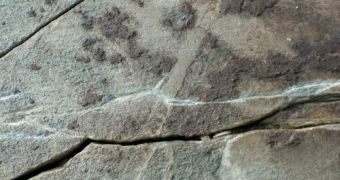Scientists are excited at the possibility of having just discovered the oldest, most ancient tracks ever laid by a creature walking on Earth. The markings have now been estimated to be around 565 million years old, which makes them the oldest relics of ground-based locomotion ever. This means that the animal that made them moved on the seafloor in a way similar to the one employed today by sea anemones. They date from the Ediacaran Period, which is the last geological period of the Neoproterozoic Era, immediately before the start of the Cambrian Age, ScienceDaily reports.
The fossilized tracks were discovered in the Newfoundland territories of Canada. They were immediately investigated by an international team of experts in the field, who were led by experts at the Oxford University, in the United Kingdom. Surface analysis has revealed that several species of creatures moved across the region, which was once a seafloor, leaving behind more than 70 fossilized tracks. The features are very likely to allow researchers to gain a new perspective into how life must have looked like at the time. Further data about the primordial animals to have ever lived could also help determine common ancestors for several modern species, or for animals long extinct.
“The markings we've found clearly indicate that these organisms could exert some sort of muscular control during locomotion. This is exciting because it is the first evidence that creatures from this early period of Earth's history had muscles to allow them to move around – enabling them to hunt for food or escape adverse local conditions and, importantly, indicating that they were probably animals,” Oxford Department of Earth Science expert Alex Liu explains. He is also the author of a paper detailing the finding, which was published in the February issue of the esteemed scientific journal Geology.
“As yet we aren't able to say which Ediacaran organism created these trails, but this is evidence that these creatures had muscles as well as the stiff tissues, such as collagen, that gave their soft bodies some rigidity. It is also evidence that the ecology of this ancient marine environment was quite complex, perhaps approaching the complexity of later epochs. Remarkably, these newly-discovered fossils occur at a site called Mistaken Point which has been traversed by countless researchers over the years. It just goes to show that these old rocks still have many new things to tell us,” the expert adds.
The Ediacaran Period stretched between 630 and 542 million years ago, so not much is known about it. One of the main reasons for this is that not even sea creatures had yet developed solid shells, which means that the chance of them leaving behind fossils is very remote. Hard tracks are the best bet for researchers, but thus far discoveries of such structures have been sparse at best.

 14 DAY TRIAL //
14 DAY TRIAL //